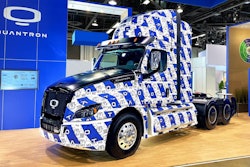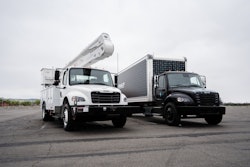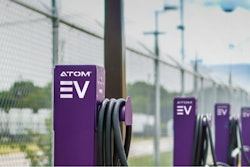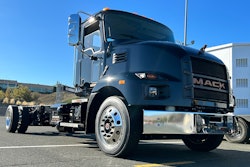Speaker 1 (00:00):
2027 may be the final year for new on-road diesel engine development, according to the 2023 State of Sustainable Fleets report, a document that highlights the latest trends in five different categories of sustainable transportation.
Nate Springer (00:16):
We put together the State of Sustainable Fleets to provide a technology neutral, incredible resource for fleet operators. We do a survey of over 200 fleet operators of 11 different fleet types on how these technologies are performing, including drop-in solutions for diesel. So that includes efficiency and renewable diesel. It also includes CNG, propane, and battery electric and fuel cell electric vehicles.
Speaker 1 (00:40):
Will these technologies really replace the diesel engine by 2027? And what does this mean for you, a fleet professional? Learn about these seven surprising facts to find out. This video was filmed at the Advanced Clean Transportation Expo. For more coverage from this show, make sure to subscribe and click the notification bell so you don't miss another video.
(01:05):
Funding is expected to average 32 billion annually for the next four to five years with the focus on the zero emission vehicle market. Where is that money coming from and how can fleets get ahold of it?
Nate Springer (01:19):
Funding really underpins the development and adoption of new clean technology by fleet operators. We're seeing an uptick of about 32 billion total, probably from an average of about 3 billion historically. A lot of that's coming from the federal government, and the federal government in some cases is creating new programs that they're operating by the EPA or the Department of Energy. In a lot of cases though, they're also giving that money to the states, and so each state is deciding how to use that funding.
(01:46):
Some of it's earmarked for zero emission technologies because the intent of the federal government is to be building the market. So they're investing in chargers or they're investing in hydrogen hubs, for example. But then there's a lot of it that is available to fleet operators to convert to these new technologies. But each program is very specific. It's both a smorgasbord, but it's also like the tax code. There's just so many different programs. It's really a challenge to navigate and you probably want to talk with your OEM partners, your infrastructure partners or companies like GNA that can help you find that funding and go after it to help you convert.
Speaker 1 (02:22):
Publicly announced orders of over-the-road Class 2 through 8 battery electric vehicles rose 640% from 4,500 in 2021 to more than 33,000 in 2022.
Nate Springer (02:37):
We're seeing an explosion of interest by fleets in the battery electric technology and charging, et cetera. And it seems to now be proliferating across basically every fleet type. And probably what's going to happen is we'll see very strong growth early on in the next couple of years in, for example, the drayage market with shorter distances and a lot more back and forth, also, the yard tractor segment on the Class 8 side, and the total cost of ownership will start to make a little more sense.
Speaker 1 (03:05):
Total cost of ownership is a big issue when it comes to Class 8 BEVs. The base price of one is between 350,000 and $500,000, which is three to five times the base price of a new diesel truck. National electrical grid capacity needs to grow 60% by 2030 and by 300% by 2050 to meet electrification and zero carbon power goals.
Nate Springer (03:34):
Infrastructure has really emerged as the big challenge to early adoption and scaled widespread adoption of battery electric vehicles. Utilities are a very different business and they are just now newcomers to the fleet market. The ones who are trying to lead on this are setting up what they call Make-Ready programs where they can actually help fleet owners cut the cost of installing the infrastructure, and they're trying to match their timelines and deployment schedules with the actual arrival of the vehicles and the fleet project schedules. But what's interesting is we're also seeing a lot of innovation in the marketplace whereby a number of companies are providing trucking as a service, for example. So they're taking the question of charging off of the hands of fleet operators, and then you just can make it their problem and they find the real estate and they get the power there and they set up charging.
(04:25):
And we also saw, for example, Walmart has now gotten into the game providing fairly high-powered charging in all of their Supercenters around the nation. So these types of innovations tell us two things: A, there's still a lot of uncertainty on the utility side, but B, there's a lot of innovation that's happening and already emerging that is very likely going to shorten the challenges and the length of problem that this is. Are we going to have charging challenges for years? Probably. But we will also have more and more solutions and opportunities for charging throughout the country.
Speaker 1 (05:02):
While total reported purchases of battery electric yard trucks grew by more than 225%, reported deployments only grew 64%. Even though this statistic is only for yard trucks, does it represent a larger supply chain issue?
Nate Springer (05:19):
We are seeing the after effects of COVID and a number of other global challenges that are disrupting all technology types and all vehicles, even diesel and other vehicles. But you see it more in newer markets; they're just small. I think absolutely this is probably going to be a challenge in the near term that these types of supply chain disruptions are going to happen probably in the battery electric segment. They probably have happened also in the compressed natural gas CNG segment. They will likely affect the hydrogen segment in the next three to five years, would be my guess, before these segments really start to iron out and build out their supply chains to a level of reliability and redundancy where it has a smaller effect than the disruptions that we see going on in the diesel vehicle markets.
Speaker 1 (06:07):
83% of battery electric vehicle users rely primarily on private charging infrastructure. What does this say about the battery electric vehicle landscape? Is this an issue?
Nate Springer (06:20):
I think it's fascinating to see that fleets, the ones who really want to get into battery electric vehicles, are starting to just tackle the charging problem themselves by doing it onsite at their own depots, their own facilities and such. So I don't read too much into that as either a barrier or an opportunity. We do think that there is going to need to be a larger build out in the public charging network before this can truly be scaled as a technology that, especially fleets that don't have depots, that are dependent on the public network, are going to have to use.
Speaker 1 (06:52):
According to the Diesel Technology Forum, compared to a full electrification strategy between now and 2032, three times the reduction in carbon dioxide emissions can be achieved at 25% of the cost by accelerating the turnover of older trucks to new advanced technology diesel models, and by utilizing low carbon renewable diesel and biodiesel across the entire fleet. Why do battery electric vehicles get all the buzz when drop-in solutions like renewable diesel and biodiesel can have a greater impact in the near term?
Nate Springer (07:30):
Yeah, it's a fair question and I think it's important for fleets to understand we are in a new era of technological transformation that this industry has never before seen, and I think there's going to be an all-of-the-above approach required for most fleets, right? And not every technology is going to work well for every single fleet, but most fleets are going to have to, A, maximize the efficiency of their vehicles all day every day; that's just a come to work issue for fleets. B, start to get familiar with some of the renewable, what we call drop-in options. So that includes up to 20% biodiesel blends and up to fully replacing your fossil based diesel with renewable diesel, so almost a 100%.
(08:11):
Familiarize yourself with these technologies as a starting point because they're fairly easy; they're drop in, they're easy to start out with and use. And in states like California that have these marketplaces, renewable diesel is actually at or cheaper than the cost of diesel. So why wouldn't you do something that saves you money?
Speaker 1 (08:29):
Manufacturers and fleets reported fewer than 100 heavy duty fuel cell electric vehicle orders in 2022, down from an estimated 140 in 2021. What does that say about hydrogen fuel cell trucks and technology?
Nate Springer (08:46):
The hydrogen fuel cell markets is at a super early stage still. We're looking at around a hundred per year being deployed, and most of those are demonstrations. There's a few transit buses that are early commercial, but we're still at the very first chapter of hydrogen. We finally got here. We'll see the first commercial deliveries of fuel cell electric tractors this year by a couple of companies and even more coming online by big names like Toyota and Kenworth and Hyundai. So that to me is a major milestone.
(09:14):
We think that the fuel cell electric market will scale. We think that it's going to offer a great solution, especially for over-the-road. The fueling times are similar to diesel. They're pushing the range limits right now in some of the demonstrations that are being done by Hyundai and Hyzon and others. It's just at an early stage. So get your hands on them if you can and get to try them out, and then think about where that might fit in your operations.
Speaker 1 (09:37):
Finally, why does 2027 signal the end for the diesel engine?
Nate Springer (09:42):
So we saw regulators at both the state, California, as well as federal level pass regulations where 2027 model year vehicles are going to have to meet very aggressive 80% reductions in NOx emission standard. Most of the diesel manufacturers are indicating it's going to be either very expensive or just not worth the investment by them to continue developing diesel engines past 2027. So we think we're entering a sunset era of diesel engine development. There'll be diesel engines sold in service for the next two decades. But in terms of developing new engines, we think 2027 is likely the year that that's going to sunset.
Speaker 1 (10:21):
For the latest in clean transportation, subscribe to our daily newsletter by clicking the link below.










